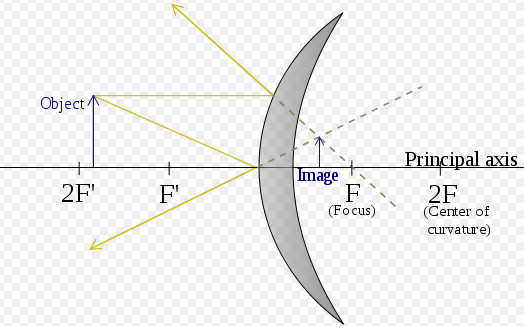
If the image formed by a mirror for all positions of the object placed in front of it is always erect and diminished, what type of mirror is it? Draw a ray diagram to justify your answer. Where and why do we generally use this type of mirror?
Answer
553.5k+ views
Hint:There are three types of mirrors:
-Concave mirror: It is considered a concave mirror if the inner side of the spherical mirror is reflective.
-Convex mirror: It is considered a convex mirror if the outer side of the spherical mirror is reflective.
-Plane mirror: A plane mirror is a mirror that has a reflective (planar) flat surface. The angle of reflection equals the angle of incidence for light rays striking a plane mirror.
Complete step by step answer:
A plane mirror forms a virtual image. The image and object are the same distance from a flat mirror, the size of the image is the same as the size of the object and the image is upright.A magnified and virtual image is acquired when the concave mirror is located very close to the object. However, if we increase the distance between the object and the mirror, the size of the image will decrease and the actual image will be produced. The image created by the concave mirror can, thus, be small or large and can be real or virtual as well.A convex mirror is also known as a diverging mirror, as this mirror deviates from the light when it strikes the reflective surface. Convex mirrors are often created with virtual, erect, and diminished images, regardless of the distance between the object and the mirror.

Convex mirrors are commonly used in cars and buses as rear-view mirrors as they can diverge rays of light and produce virtual images.
Hence, from the above discussion we can say that convex mirrors erect and diminished images.
Note:Here we have to pay attention as to what type of image formation is given in the question. Erect and diminished images are only formed by convex lenses. If we write concave lenses instead of convex then the answer would be wrong.
-Concave mirror: It is considered a concave mirror if the inner side of the spherical mirror is reflective.
-Convex mirror: It is considered a convex mirror if the outer side of the spherical mirror is reflective.
-Plane mirror: A plane mirror is a mirror that has a reflective (planar) flat surface. The angle of reflection equals the angle of incidence for light rays striking a plane mirror.
Complete step by step answer:
A plane mirror forms a virtual image. The image and object are the same distance from a flat mirror, the size of the image is the same as the size of the object and the image is upright.A magnified and virtual image is acquired when the concave mirror is located very close to the object. However, if we increase the distance between the object and the mirror, the size of the image will decrease and the actual image will be produced. The image created by the concave mirror can, thus, be small or large and can be real or virtual as well.A convex mirror is also known as a diverging mirror, as this mirror deviates from the light when it strikes the reflective surface. Convex mirrors are often created with virtual, erect, and diminished images, regardless of the distance between the object and the mirror.

Convex mirrors are commonly used in cars and buses as rear-view mirrors as they can diverge rays of light and produce virtual images.
Hence, from the above discussion we can say that convex mirrors erect and diminished images.
Note:Here we have to pay attention as to what type of image formation is given in the question. Erect and diminished images are only formed by convex lenses. If we write concave lenses instead of convex then the answer would be wrong.
Recently Updated Pages
Master Class 10 General Knowledge: Engaging Questions & Answers for Success

Master Class 10 Science: Engaging Questions & Answers for Success

Master Class 10 Social Science: Engaging Questions & Answers for Success

Master Class 10 Maths: Engaging Questions & Answers for Success

Master Class 10 English: Engaging Questions & Answers for Success

Master Class 10 Computer Science: Engaging Questions & Answers for Success

Trending doubts
Why is there a time difference of about 5 hours between class 10 social science CBSE

Write a letter to the principal requesting him to grant class 10 english CBSE

What is the median of the first 10 natural numbers class 10 maths CBSE

The Equation xxx + 2 is Satisfied when x is Equal to Class 10 Maths

Which of the following does not have a fundamental class 10 physics CBSE

State and prove converse of BPT Basic Proportionality class 10 maths CBSE




